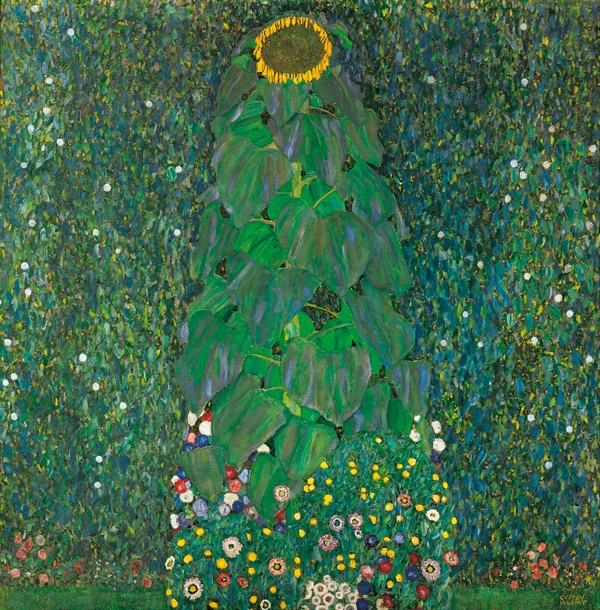Gustav Klimt first came to Venice in the spring of 1899, in pursuit of Alma Schindler, the young stepdaughter of his friend and fellow artist Carl Moll. The nascent love affair between the artist, who was then in his late thirties, and the 19-year-old Alma was brought to an abrupt end when the girl’s mother read her diary and Klimt was asked to leave. Three years later she married Mahler. But before Klimt departed from Venice, Klimt and Alma had visited San Marco where, as Alma recorded, the Basilica’s mosaics, glittering in the half-light, made a profound impression on him.
Although he had experimented with gold-painted highlights in his ‘Pallas Athene’ of the year before, the Venice visit, according to Alfred Weidinger of the Belvedere in Vienna and the curator of this evocative exhibition, stimulated Klimt to make lavish use of the gold leaf that was to become the trademark of his ‘Gold Period’.
Timed to coincide with the 150th anniversary of Klimt’s birth, this exhibition demonstrates the extraordinary transformation Klimt’s style underwent during the 1890s.
The son of a poor goldsmith, Klimt entered Vienna’s applied arts school at 14, where he received a thorough traditional training in drawing and painting. He was joined there by his brother Ernst and Franz Matsch. Three years later the trio went into partnership and over the next decade they gained substantial commissions for decorative schemes for public buildings, including theatres in Bohemia, Romania, and for the new Burgtheater and Kunsthistorisches Museum in Vienna.
The first room of the show displays academic male nudes and portraits by all three from these early days, which reveal a remarkable homogeneity in style and contain no hints of the radical change that Klimt’s art would later undergo.
In the 1880s the most notable foreign influence on both Gustav and Ernst Klimt’s work was seemingly the Pre-Raphaelites. But after Ernst’s death in 1892, the Belgian Symbolists, particularly Fernand Khnopff, Jan Toorop and George Minnie, had a striking effect on the direction Gustav’s painting took, the minutely observed, almost photographic quality of his previous canvases giving way to a new, atmospheric blurring of outlines and subtle gradations of colour — as is demonstrated here by the juxtaposition of a number of works by these Belgian symbolists with Klimt’s own.
When the Vienna Secession was launched in May 1897, Klimt was sufficiently prominent as a radical artist to be chosen as its president. A few weeks later, the architect and designer Josef Hoffmann joined the group. A fellow believer in the ideal of the Gesamtkunstwerk, or total artwork, combining multiple arts and crafts, Hoffmann soon become Klimt’s close friend and collaborator.
Hoffmann is represented in this show by over a score of pieces, from drawings and models of his buildings, to furniture and designs for carpets, tapestries and jewellery.
The Secession’s most memorable event was the 1902 Beethoven exhibition, designed by Hoffmann and centred on Max Klinger’s polychrome statue of the composer. In all, 22 artists contributed, and Klimt’s ‘Beethoven Frieze’, a bold attempt to render the Ninth Symphony in visual form, became a succès de scandale, both praised and attacked as ‘the utmost ever achieved in the field of obscene art’. Although conceived as a temporary installation, the ‘Frieze’ was rescued and put in store when the show was dismantled. Too delicate to travel, the ‘Frieze’ appears at the Venice show in the form of the Belvedere’s expertly executed copy, made at the time of the fresco’s restoration in the 1980s.
Klimt once declared his principal interest to be ‘other people, mainly women’. Of his thousands of drawings of women a large proportion are nudes and frankly erotic. He never married, but was said to have fathered 14 children by various partners.
The subjects of his sumptuous, painstakingly constructed portraits were almost exclusively women, many from Vienna’s Jewish haute bourgeoisie whose appreciation of avant-garde art was generally far ahead of that of the rest of Viennese society. The artist’s portrait of Hermine Gallia, the wife of one of the artist’s most dedicated patrons, from the National Gallery in London, is one of several on loan here from public and private collections.
Klimt’s closest lifelong friend was Emilie Flöge, although it is unclear whether the artist ever had a physical relationship with her (she was said by some to be a lesbian) and he did a number of portraits of her. Flöge was a successful dress designer and promoter of modern reformed styles. Klimt was a frequent visitor to the Flöge family summer house on Attersee, where he took photographs of her in the gardens on the lake wearing her own designs. There are remarkable similarities between these and his gold-flecked ‘Sunflower’ of 1907, which was donated to the Belvedere as recently as March this year and is on show in Venice. Indeed, it has all the appearances of being a highly unusual, anthropomorphic image of Emilie.





Comments